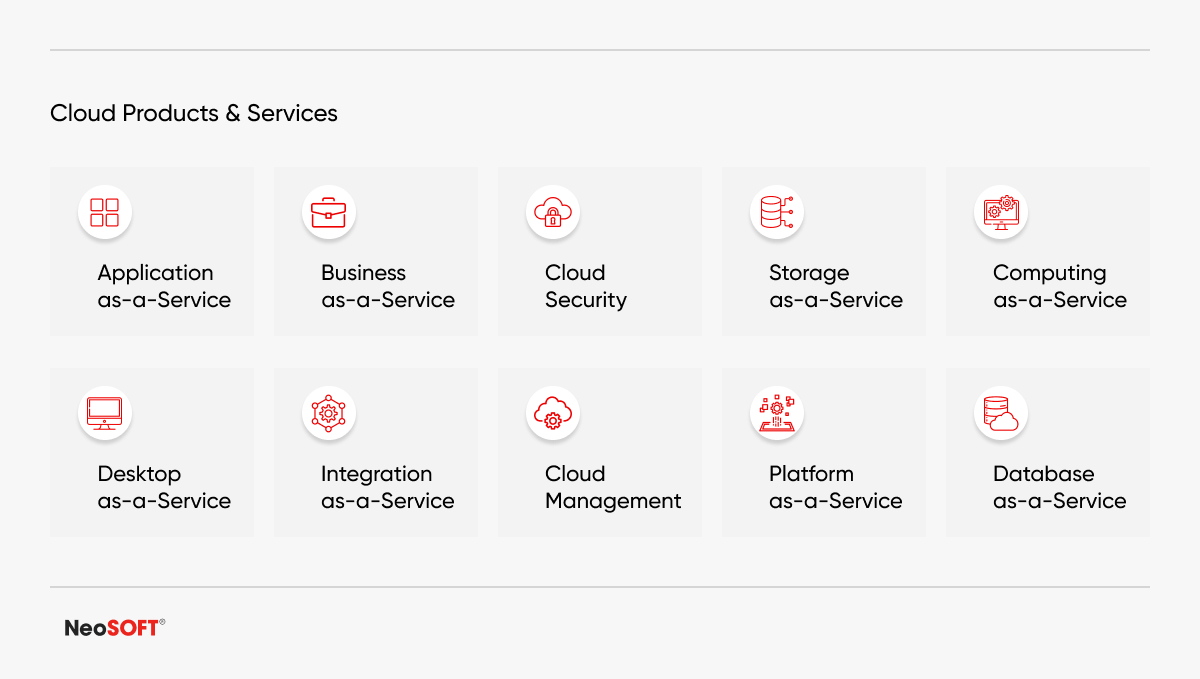Leveraging The Cloud To Deploy A Winning Enterprise IT Strategy
October 13, 2022
Organizations require to establish comprehensive enterprise IT strategies to fulfil the overarching business requirements and stay competitive. Information Technology constantly evolves to provide new ways to do business, and the last decade saw the emergence of cloud computing solutions as a powerful technology to drive long-term benefits for an enterprise.
IT infrastructure is a broad field comprising different components such as network and security structure, storage and servers, business applications, operating systems, and databases. Organizations are grappling with key challenges when it comes to scaling up their IT infrastructure.
⦁ Difficulty in keeping the IT team abreast with the latest IT infrastructure advancements and complexity, which subsequently also impacts productivity.
⦁ High expense ratios such as almost about 70% of the IT budget are spent on maintaining current IT infrastructures, and only around 30% of the IT budget is spent on new capabilities.
⦁ Infrastructure security which is a primary concern for all businesses is predicted to face security breaches of 30% of their critical infrastructure by 2025.
In this blog, we’ll explore some critical top-of-the-mind questions for cloud professionals, such as-
⦁ How do I keep pace with the rate of innovation in the evolving and ever-dynamic environment?
⦁ How could IT help me gain a competitive advantage against new competitors?
⦁ What is the best strategy to optimize IT costs? How do I find the perfect balance between fixed and variable IT costs?
⦁ Which cloud consumption models are best suited for my organization’s business model?
⦁ What is the right strategy for cloud adoption? Observe and implement or predict and innovate?
⦁ How to get started with cloud pilots?
Exploring the Potential of Cloud Computing
Cloud computing solutions have been a key enabler for big innovations in enterprises and could provide the answers to the myriad of questions that challenge CIOs today. Cloud computing services enable enterprises to become more agile. Cloud offers better data security, data storage, extra flexibility, enhanced organizational visibility, smoother work processes, more data intelligence, and increased employee collaboration. It optimizes workflows and aids better decision-making while minimizing costs.
Cloud has now moved from merely being an on-demand and grid computing platform and is now tapping into advancements in virtualization, networking, provisioning, and multi-tenant architectures. Cloud services are critical to building leaner and more nimble IT organizations. It gives companies access to innovative capabilities with robust data centers and IT departments.
The first step to designing a cloud strategy is to outline the business goals and the challenges the cloud will be able to resolve. A holistic approach to creating a cloud strategy will help create an adaptable governance framework empowering businesses with the flexibility to handle different implementation demands and risk profiles.
How Does Cloud Create Tangible Business Value for Enterprises?
Cloud computing and digital transformation are integral to modernizing the IT environment. Listed here are the top six cloud value drivers that are transforming the enterprise business strategy:
⦁ Catalyzing business innovation through new applications developed in cost-effective cloud environments.
⦁ Maximizing business responsiveness.
⦁ Reducing total ownership cost and boosting asset utilization.
⦁ Offering an open, flexible, and elastic IT environment.
⦁ Optimizing IT investments.
⦁ Facilitating real-time data streams and information exchange.
⦁ Providing universally accessible resources.
Let’s dive deeper into how cloud computing creates tangible value for enterprises.
Reducing operating costs and capital investments
Cloud computing services encompass applications, systems, infrastructures, and other IT requirements. By adopting the cloud, companies can save an average of 15 % on all IT costs. Cost optimization is the main reason why 47% of enterprises have opted for cloud migration.
Cloud services provide natural economies of scale allowing businesses to pay only for what they need. Businesses can achieve cost savings with the cloud as it optimizes both software licenses and hardware or storage purchases both on-premise or within the data center. A cloud strategy allows businesses to reduce upfront costs and shift to an OpEx model.
Pay-for-use models enable businesses to access services on-a-need basis. Cloud lowers IT costs and frees up time to focus on optimization, innovation, and more critical projects. Enterprises could prune their IT operations and allow CSPs to manage all operating responsibilities using cloud solutions that sit higher in the stack.
Access to finer-grained IT services
Cloud eliminates multiple barriers that stand in the way of small enterprises. Small enterprises often don’t have the resources to access sophisticated IT infrastructure and solutions. Cloud allows small enterprises to access IT solutions in small increments depending on their budget and business goals without compromising efficiency and productivity. The biggest advantage of cloud models is that they open up access to flexible solutions that are otherwise economically not feasible. Cloud computing solutions, before, level the playing field for small businesses and allow them to compete with larger enterprises.
Eliminating IT complexity for end users
Cloud can simplify IT systems making it easy for businesses to operate. With the cloud, users don’t have to bother about upgrades, backups, and patches. Cloud providers can handle all these functions so users are ensured of seamless access. Cloud’s open approach architecture paves way for new IT outsourcing models. So far, cloud models primarily catered to large enterprises with large IT requirements and at times had lesser scope to accommodate the IT requirements of smaller enterprises. However, the advent of the cloud has enabled small companies to access quality IT services at affordable rates. Mobility and data security are the two key areas where businesses will benefit from the cloud.
Leveraging the pay-per-use cost structure for cloud IT services
Cloud has transformed IT costs from fixed costs to variable costs. That means enterprises with varying IT requirements can safely rely on the cloud. Enterprises may have varying storage needs and the pay-per-use cost structure is highly beneficial for such enterprises. Large enterprises can expand or contract capacity for select applications if they already have existing IT infrastructure.
As updates are included in the cost, enterprises don’t have to deal with obsolescence. An organization’s overall IT requirements determine to what extent the IT costs will transform into a variable cost structure. The cloud allows businesses to trade fixed expenses like data centers and physical servers for variable expenses and only pay for IT services as they are used. The variable expenses are much lower compared to the capital investment model.
Standardizing applications, infrastructure, and processes
Digital transformation and cloud adoption are foundational to standardizing applications, infrastructure, and processes. A ‘lift and shift’ approach where legacy applications are simply moved to the cloud will not yield benefits. The dynamic features of the cloud help replace current processes with industry best practices to eliminate process bottlenecks and high costs. Standardization helps tame the complexity of modern infrastructures and their potential pitfalls. Cloud-driven solutions can also replace non-core applications that greatly improve business processes and provide the level of transparency and standardization that modern companies are looking for. Cloud-based data standardization is driving digital transformation across business functions in multiple industries. Cloud makes applications more scalable and interoperable and opens access to a scalable set of secured solutions.
Cloud computing for organizations in emerging markets
Organizations in emerging markets have been quick to realize the benefits of cloud computing. Cloud computing represents a paradigm shift; it has transitioned from ‘computing as a product’ to ‘computing as a service.’ Organizations in emerging markets get an opportunity to leapfrog their counterparts in developed countries with cloud adoption. Rather than buying hardware and software and investing in maintenance and configuration, cloud computing services enable companies to use applications and computing infrastructures in the cloud-as-a-service (CaaS).
Cloud piloting
Capturing the benefits of cloud adoption requires a holistic approach. Even companies that once preferred to have their own IT infrastructure and systems are shifting to the cloud to leverage its scalability and higher-order functionality. Pilots help determine the impact of cloud adoption on core IT operations as well as the business model. An initial assessment of the impact of the cloud is integral to creating a sound cloud strategy.
Businesses that adopt a cloud-first approach will witness a significant impact on their products/services and delivery and sales models. Pilots should be initiated depending on whether cloud adoption will impact the application layer or infrastructure layer in your enterprise. A decrease in time to market for new applications is a crucial benefit of cloud adoption.
How to Get Started with Cloud Computing?
While some enterprises have adopted a hybrid approach, others have moved to a private or public cloud solution. Companies have embraced the cloud in one way or another as a part of their digital transformation journey. Moving to the cloud will enable businesses to focus on more strategic problems like accurately forecasting through good data management and automating repetitive business processes.
Though the cloud is no longer in its infancy, many enterprises are still faced with challenges when it comes to starting their cloud computing journey. Conducting a pilot is the perfect way to start the cloud computing journey. You can choose from a variety of products and services to conduct a cloud pilot.

Conducting a Successful Pilot? Following are the Key Steps to Follow:
Step 1: Assess your business need
Define the business imperatives and determine key areas where the business needs to integrate with the cloud. Assess the triggers for cloud transformation. If you want to reduce costs or accelerate digital innovation, you will need to conduct pilots accordingly. Cost reduction and performance improvement of business applications will require you to conduct a SaaS pilot.
Step 2: Evaluate options
Take the SaaS pilot as an example. You would have multiple providers to choose from, all with capabilities and experiences that match your requirements. You must evaluate the level of cloud adoption in your industry and assess how various Saas providers match up to that. The evaluation should support the logic used to determine the right type of pilot for your business.
Step 3: Launch the pilot
The final step is to launch the pilot and collect data that will give insights into the road ahead in your cloud computing journey. The data collected at this stage will form the basis for your future cloud strategies and serve as the cornerstone for creating a robust, data-driven, and actionable cloud adoption blueprint for your organization. Once you’ve done a pilot, you can move to the next phase of your cloud journey.
How can NeoSOFT Help?
NeoSOFT can help businesses in their digital transformation and cloud adoption journey with its sustained digital capabilities. We leverage the most in-demand technologies, methodologies, and framework components to craft effective cloud strategies that bring substantial value to businesses. NeoSOFT drives stronger business results by taking a holistic approach to cloud integration.
Here is a quick overview of the NeoSOFT strategy to assist clients with cloud adoption:
1. Readiness analysis
A ‘one cloud-fits-all’ approach won’t work for businesses of different sizes and goals. The first step is to pinpoint the areas in dire need of cloud services. This can be achieved by conducting a deep analysis of the business models, goals, opportunities, and weaknesses. The organization’s skills, resources, and capabilities are taken into consideration at this stage. Its ability to adapt to change and ways to minimize potential project failure are key concerns addressed.
2. Formulating strategy
We create an effective IT strategy that maps to business goals and focuses on deriving outcomes that are sustainable, scalable, and secure. Our strategy is based on principles of agility with faster and safer adoption techniques.
3. Creating a roadmap
This step includes prioritizing workloads to target in the pilot. We help develop initial cloud configurations with associated cost analysis. We create a strategic roadmap designed according to best practices and your organization’s policies and standards. This phase is focused on developing cloud strategies that will keep your cloud infrastructure right-sized and cost-efficient over the long term.
Wrapping Up
Cloud has undoubtedly had a massive impact on the enterprise-technology ecosystem. In 2020, 81% of technology decision-makers said their company already made use of at least one cloud application or relied on some cloud infrastructure. The two key aspects of cloud computing, as with any other technology, are cost reduction and risk mitigation. A well-architected cloud environment is integral to reaping the full benefits of cloud technology. Legacy applications pose risks such as security issues to organizations. A sound cloud strategy takes into consideration cost recovery and risk mitigation. Businesses must prioritize investments in cloud transformation after performing a thorough assessment of their existing business models.
The cloud transformation journey for each organization is unique. The cloud strategy depends on multiple factors such as risk appetite, scope, existing technology stack, and budget. Even organizations planning to start small should consider cloud adoption as a vital part of their IT enterprise strategy to accelerate digital transformation and stay ahead of the competitive curve.


















